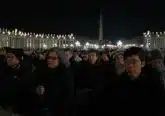Solitary confinement in U.S. prisons qualifies today as torture

IMAGE: CNS photo/Robert Galbraith, Reuters
By Mark Pattison
WASHINGTON (CNS) — Few people think about it in these terms, even around Easter, but Jesus was tortured as a prisoner before his death on a cross. There’s no other way to characterize the 39 lashes ordered by Pontius Pilate, or the crown of thorns. Or, for that matter, the lance in his side to see if he was really dead or just looked dead.
It brings into sharp focus that, while the methods have changed over the past 2,000 years, torture remains part of prison life.
The federal Justice Department report April 3 on prison conditions in Alabama told of "a high level of violence that is too common, cruel, of an unusual nature and pervasive." Among the findings, none of which were ever tracked by the state: 15 prison suicides in the past 15 months, a prison homicide rate well above the national average, and sexual assaults in "dormitories, cells, recreation areas, the infirmary, bathrooms, and showers at all hours of the day and night."
The investigation began after a series of lawsuits earlier in the decade and published reports describing brutality, violence — and torture — in state prisons.
While states are rarely subject to the kind of federal scrutiny Alabama received, U.S. prisons have rarely been held up as models for rehabilitation. Even some tactics used in prison meant to rehabilitate prisoners now qualify as torture.
One such tactic is solitary confinement.
Benjamin Franklin and several Quaker leaders first instituted solitary confinement in Philadelphia in the late 18th century, believing that total isolation and silence would lead to penitence — from which we get the name "penitentiary."
Instead, enforced solitary confinement led to severe mental health problems for prisoners, including insanity. "I believe it … to be cruel and wrong," said novelist Charles Dickens after a visit to a Pennsylvania penitentiary that had nothing but solitary confinement cells. "I hold this slow and daily tampering with the mysteries of the brain, to be immeasurably worse than any torture of the body." The Quakers later apologized for their advocacy of long-term solitary confinement.
Yet the practice persists.
"We oppose the increasing use of isolation units, especially in the absence of due process, and the monitoring and professional assessment of the effects of such confinement on the mental health of inmates," said the U.S. bishops in their 2000 statement "Responsibility, Rehabilitation and Restoration: A Catholic Perspective on Crime and Criminal Justice."
"One form of torture is … confinement in high-security prisons," said Pope Francis in an Oct. 23, 2014, address.
"As shown by studies carried out by various human rights organizations, the lack of sensory stimuli, the total impossibility of communication and the lack of contact with other human beings induce mental and physical suffering such as paranoia, anxiety, depression, weight loss and significantly increase the suicidal tendency," Pope Francis said.
The National Religious Campaign Against Torture, or NRCAT, which is based in Washington, has led two-track initiatives decrying torture in prisons both in the United States and abroad.
Leading the U.S. side of the initiative is Johnny Perez, who knows something about extended solitary confinement.
"I was a total of three years in solitary. The longest was 10 months; that was testing positive for cannabis consumption — smoking weed, in other words," Perez told Catholic News Service in an April 16 telephone interview from New York. "I rely on that experience" in working against torture, he added.
Asked how he made it through, Perez, who was raised Catholic, replied, "Lots of prayer, if that hasn’t been obvious," adding a hearty chuckle afterward. "Meditation and understanding. And also the thought that if I don’t make it, they win."
Perez said NRCAT works at "engaging faith leaders and mobilizing them" on the issue, "not only with correctional facilities but also legislators."
Faith leaders can be found nearly anywhere. Earlier this decade, NRCAT took its solitary prison cell replica — a 6-foot-by-9-foot windowless box featuring audio from a maximum security prison in Maine — to a national Catholic youth conference in Indianapolis. "People are invited to sit in the cell — for up to one hour — and those who have are very moved and motivated to take action," said the NRCAT website, www.nrcat.org.
In New York, New Jersey and California, according to Perez, "faith leaders have been able to create mitigation teams where they have direct communication with correctional staff to find some middle ground on what needs to change."
"Between policy and practice is a huge space, And to close that space, we need people who have been affected by these issues to directly engage," Perez said.
One high-water mark in the campaign against solitary confinement came in 2012, when the Senate Subcommittee on the Constitution, Civil Rights and Human Rights conducted a hearing on the practice.
The Innocence Project, based at the Benjamin N. Cardozo School of Law in New York, submitted testimony on behalf of several prisoners, exonerated after their conviction, of their time in solitary.
Julie Rea testified she was placed in solitary in an Illinois prison to keep her from harming herself and was then tormented by prison guards who played a recording of a woman being tortured to prevent her from sleeping. Cornelius Dupree, exonerated by DNA after spending 30 years in Texas prisons, recounted receiving one complete meal only every three days when he was in solitary. The other two days he received a spoonful each of rice and beans and a roll.
Nicholas Yarris, freed in 2003 after spending 23 years in solitary confinement on death row in Pennsylvania attempted suicide in prison. Despite his innocence, he asked a year before his exoneration that he be executed rather than continue to be held in what he called "endless degradation."
Clarence Elkins testified he had to spend the last three months in solitary confinement, despite evidence of his innocence to "protect" him from the person who had actually the crime in his case and was housed in the same prison.
Herman Atkins spent 11 years in prison in California, 16 months of it in solitary, before being exonerated. While in solitary, he said he was confined to a small windowless room with a light always on to allow correction officers to watch him at all times, and "when a government has the authority to treat people so poorly," he testified, "it’s impossible to hold citizens to a higher standard."
NRCAT asks its affiliates and prison reform advocates to take part in "Together to End Solitary" actions the 23rd of each month. The 23rd is chosen because of the 23 hours each day a prisoner typically spends in solidarity.
"For 23 hours a day for months, years, even decades, more than 80,000 adults and youth are held in solitary confinement in U.S. prisons, jails and detention centers," the NRCAT website says.
Study guides for people of different faiths are available from NRCAT, including one for Catholics. The Catholic study guide features this admonition from Hebrews 13:3, which NRCAT translates as, "Remember those in prison, as though you were in prison with them; those who are being tortured, as though you yourselves were being tortured."
– – –
Copyright © 2019 Catholic News Service/U.S. Conference of Catholic Bishops. www.catholicnews.com. All rights reserved. Republishing or redistributing of CNS content, including by framing or similar means without prior permission, is prohibited. You may link to stories on our public site. This copy is for your personal, non-commercial use only. To request permission for republishing or redistributing of CNS content, please contact permissions at [email protected].













